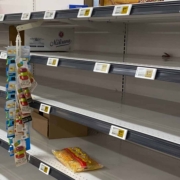7 Reasons Your Inventory Optimization Software Is Not Working
Predicting the Unpredictable: Inventory Optimization Software
Inventory Optimization – nine syllables, two words, one concept. It means having what you need when you need it. Too much inventory can cut your profit margin; too little inventory can prevent you from meeting demand and tip your customers toward the competition. Sounds simple: but in reality, the inventory optimization math any supply chain process will use is as important as the metal alloy used in forging a chain of metal links. You can find cheap, plastic chains, and you can find expensive chains formed from strong metal alloys with all kinds of irresistible names and features.
How Strong is the Inventory Optimization in your Supply Chain?
The question is: How do you calculate your optimal inventory level? It’s like trying to predict the weather – no matter how many variables you take into consideration, you inevitably fail to account for something – Offshoring, transportation costs, commodity trends, globalization, new product introductions, extended supply chains – all these factors and an infinity of others make optimizing inventory levels a daunting task. Frankly, it is too much for the human brain to handle.
Inventory Optimization using Advanced Software
But that is why we invented computers. New IO (Inventory Optimization) software is helping businesses to predict the unpredictable. With the proper tools, you can estimate your inventory levels to maximize profit and minimize waste. Modern software can account for many different variables, the potential outcomes and summarize the choices into a simple set of graphs and charts, allowing the user to pick the best model for their business for each of their product groups.
Single and Multi-Echelon Inventory Optimization
On the whole, IO technology can be divided into two broad categories: single-echelon software and multi-echelon software. These categories are surprisingly self-explanatory. Single-echelon software can handle inventory estimates for stand-alone operations – a single distributing plant, for instance. Multi-echelon software, on the other hand, is ideal for predicting inventory needs for multi-tiered operations – say the aforementioned distributing plant comprises a single hub in a company composed of a network of specialized hubs, each with its own optimal inventory levels. To put it another way: Single-echelon software can regulate traffic on Interstate 40, whereas multi-echelon software can regulate traffic on the country’s entire Interstate system.
Read this Top Inventory Optimization Download
The most Ignored (and profitable) factors of Inventory Optimization are demand forecast accuracy, supplier constraints, and warehouse (or store) capacity. We explore these critical (why) and often overlooked components to Inventory Optimization.The 3 Most Ignored (and Profitable) Factors in Inventory Optimization
Top Down or Bottom Up Inventory Management Delivers Different IO Results
The most advanced tools are useless, however, if they are not used properly. The first step, then, in applying IO technology successfully is to identify the software that best suits the needs of your business. In an online article in Supply Chain, Marisa Brown insisted that your IO technology should focus on two goals – reducing inventory investment and improving customer service. Once you have determined which technology will help you achieve those two goals, you can apply IO technology and software accordingly.
As Brown put it, “The process – not the technology – is the key….”
Inventory Optimization – nine syllables, two words, one concept. Having the appropriate inventory at the crucial moment can be the difference between being in the black – or the red. IO technology helps you to stay a step ahead of the competition in an increasingly complex global market.
Inventory Optimization Software Has 7 Questions You Need to Ask
Modern Inventory Optimization software will meet significantly higher expectations when compared to legacy software. While legacy software will try to give the appearance of being effective, easy to use inventory optimization, the key detail to review is the data your legacy software requires to run.
What data fields does your inventory optimization software need to calculate the most profitable amount of inventory to carry? Answers to these questions will highlight your opportunities or where your current inventory optimization software and processes are lacking benefits.
- How does your inventory optimization software group the optimization – by supplier and product group or just a group?
- Does your inventory optimization software review purchase order line and header costs, acquisition and carry costs?
- Does your system account for your suppler minimum to ship (quantity & dollar requirements to ship) when calculating the optimized amount of inventory to carry?
- How does your Inventory Optimization software plan for service goals and account for gross margin and lost sales?
- Does your inventory optimization provide a list of options and costs if you cannot meet the most profitable choice?
- Can you set up alerts that tell you when the optimization math has changed?
- Finally, are the results shown as a data grid and graph with choices set up on one page for end to end visibility or are you forced to page through a collections of pages?
Finding the Right Inventory Optimization Questions
Many people review software but fail to ask the right questions. When you need help reviewing your inventory optimization software and the options that exist, Contact Us. Find the key questions you need answered when reviewing inventory optimization software. It’s it time for you to ‘Tighten the Links In Your Chain’™.
Copyright © Data Profits, Inc. 2014 All Rights Reserved.
- How to Avoid Carrying Cost Mistakes in Inventory Optimization - June 10, 2024
- 3 Common Forecasting Software Issues and How to Fix - May 20, 2024
- The Hidden Connection: Lead Time And Inventory Optimization Explained - May 13, 2024









